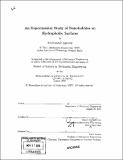| dc.contributor.advisor | Gareth H. McKinley. | en_US |
| dc.contributor.author | Agarwal, Abhinandan | en_US |
| dc.contributor.other | Massachusetts Institute of Technology. Dept. of Mechanical Engineering. | en_US |
| dc.date.accessioned | 2006-09-28T15:03:12Z | |
| dc.date.available | 2006-09-28T15:03:12Z | |
| dc.date.copyright | 2005 | en_US |
| dc.date.issued | 2005 | en_US |
| dc.identifier.uri | http://hdl.handle.net/1721.1/34104 | |
| dc.description | Thesis (S.M.)--Massachusetts Institute of Technology, Dept. of Mechanical Engineering, 2005. | en_US |
| dc.description | Includes bibliographical references (p. 123-127). | en_US |
| dc.description.abstract | With the recent development of microfluidic systems, miniaturization of flow devices has become a real challenge. Microchannels, however, are characterized by a large surface area-to-volume ratio so that surface properties strongly affect flow resistance in sub-micrometer devices. Recent studies in the literature have opened up the possibility of a controlled realization of nanobubbles- found to exist primarily on hydrophobic surfaces- that can play all important role in changing the hydrodynamic boundary condition at the fluid-solid interface giving rise to considerable reduction in friction of the fluid flow past the solid boundaries. In this study, we seek to increase our understanding of the formation, morphology, and stability of nanobubbles. Further. we seek to exploit the dependence of nanobubble formation on surface to provide a means for controlling hydrodynamic boundary conditions at the solid-liquid interface. The formation of nanobubbles at solid-liquid interfaces has been studied using the atomic force microscopy (AFM) imaging technique. Nanobubble formation strongly depends on both the hydrophobicity of the solid surface and the polarity of the liquid subphase. | en_US |
| dc.description.abstract | (cont.) First, a number of homogeneous surfaces are used as solid substrates to understand and analyze the formation and distribution of nanobubbles on homogeneous surfaces with differing degrees of hydrophobicity. While nanobubbles do not form on flat hydrophilic surfaces immersed in water. they appear spontaneously at the interface of water against smooth, hydrophobic surfaces. From the experimental evidence, we draw the conclusion that the features observed in the AFM images are deformable, air-filled bubbles. In addition to the hydrophobicity of the solid surface, differences in solubility of air between two miscible fluids can also lead to nucleation and growth of nanobubbles. We observe that nanobubbles appear at the interface of water against hydrophilic silicon oxide surfaces after in-situ mixing of ethanol and water in the fluid-cell. While for most part, the shapes of the nanobubbles are well approximated by spherical caps with width much larger than the height; in the vicinity of the three phase contact line, the shapes deviate significantly from the spherical cap profile to merge with the solid surface at a slope of < 0.05. This deviation in the interfacial profile from the spherical cap shape is due to long-range van der Waals forces, which are relevant at a spatial scale of few nanometers from the solid surface. | en_US |
| dc.description.abstract | (cont.) We quantify the morphological distribution of nanobubbles by evaluating several important bubble parameters including surface coverage and radii of curvature. In conjunction, with an analytical model available in the literature, we use this information to estimate that the present nanobubble morphology may give rise to slip lengths [approx.]1/'2 micrometer in pressure driven flows for water flowing over a typical hydrophobic surface. The consistency of the calculated slip length with experimental values reported recently in the literature, suggests that the apparent fluid slip observed experimentally at hydrophobic surfaces may indeed arise from the presence of nanobubbles. Further, trends are established between different morphological parameters and surface hydrophobicity. Bubbles are found to get bigger, wider and less-frequent in number with increasing surface hydrophobicity. The pressure inside the bubble is found to decrease with an increase in the surface hydrophobicity. The presence of nanobubbles is controlled using nanopatterned surfaces possessing repeating patterns of polystyrene (hydrophobic domains) and polymethyl-methacrylate (hydrophilic domains). | en_US |
| dc.description.abstract | (cont.) For nanobubbles to be present, we find that, in addition to controlling the degree of surface hydrophobicity, it is important for the spatial dimensions of the hydrophobic domains on the nanopatterned surface to be commensurate with the equilibrium topology of the nanobubbles. To the best of our knowledge, this is the first experimental study in which chemically inhomogeneous surfaces are used to probe the existence of nanobubbles. Thermodynamic issues related to formation and stability of nanobubbles are also discussed. The effects of line tension at the three-phase contact line is discussed for the observed set of nanobubbles. Further, the length-scale of a typical nanobubble is found to be comparable to the mean-free-path of gas molecules inside the bubble. The above fact suggests that the Young-Laplace equation- used in continuum theories for calculating pressure difference across an interface- may not be applicable in its unmodified form for the case of nanobubbles. It is noteworthy that the anomalously high pressure values obtained using this equation for nanobubbles have been the reason for much debate on the stability of nanobubbles. | en_US |
| dc.description.statementofresponsibility | by Abhinandan Agarwal. | en_US |
| dc.format.extent | 127 p. | en_US |
| dc.format.extent | 4752156 bytes | |
| dc.format.extent | 5086346 bytes | |
| dc.format.mimetype | application/pdf | |
| dc.format.mimetype | application/pdf | |
| dc.language.iso | eng | en_US |
| dc.publisher | Massachusetts Institute of Technology | en_US |
| dc.rights | M.I.T. theses are protected by copyright. They may be viewed from this source for any purpose, but reproduction or distribution in any format is prohibited without written permission. See provided URL for inquiries about permission. | en_US |
| dc.rights.uri | http://dspace.mit.edu/handle/1721.1/7582 | |
| dc.subject | Mechanical Engineering. | en_US |
| dc.title | An experimental study of nanobubbles on hydrophobic surfaces | en_US |
| dc.type | Thesis | en_US |
| dc.description.degree | S.M. | en_US |
| dc.contributor.department | Massachusetts Institute of Technology. Department of Mechanical Engineering | |
| dc.identifier.oclc | 66530147 | en_US |
